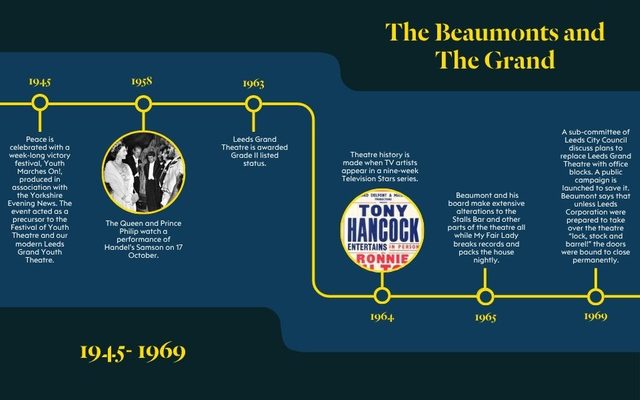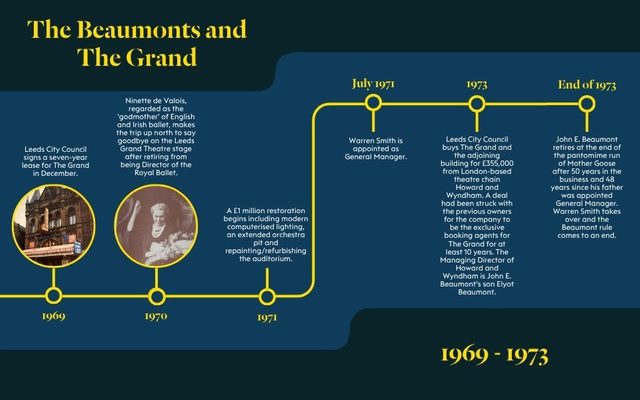
The Beaumont years at The Grand
The Grand’s history isn’t just important to us because we love our theatre dearly – it also plays a significant part in wider British regional theatre history through those who have managed it. During our trip to our archives in March, we discovered a key to arguably the most important chapter in the history of our beloved theatre: The Beaumont years. But who were the Beaumonts?
Written by Sarah Jewers and Aaron Cawood
Boats and a bookshelf
Every visit to West Yorkshire Archive Service, we find ourselves wading through boxes and stacks of historic theatre memorabilia. Whether it’s postcards of variety performers or log-books from the war, two things often prove true every visit – we find a good story, and that story has a clear connection to the history of our venues. On a recent visit, however, we found ourselves staring into a box that seemed completely disconnected to our history, inexplicably in our archive; a collection of copies of Sea Breezes, a magazine about boats.

From across the 1940s and 1950s, there was copy after copy of these small chronicles about what was new in the world of sailing. From write-ups on the hottest new boat to tales from between the tides (some of which were very juicy), each edition was made up of specialist and niche articles for sailors. Not that we ourselves are not avid sailors, but we were momentarily stumped as to why this box was in our possession. Sea Breezes has been in publication since 1918, on a small scale, until it became Sea Breezes: The Ship Lovers’ Magazine in the late 1930s. Full disclosure; we did waste an hour or so reading editions of the magazine, looking for any and all references to Leeds, but came up short. Which is when we proceeded to our next box and came upon an equally random collection of books.

In completion, these books were:
- Who’s Who in the Theatre, John Parker
- Half a Century of Entertainment, A. E. Wilson
- Ring Up The Curtain, Ernest Short and A. Compton-Beckett
- Philip Rodway and A Tale of Two Theatres, his daughters
- Howard and Wyndham Ltd. 1888 – 1948
- Yours Faithfully Leslie Henson, John Long
- Not in front of the Children, Henry Sherek
Among these were also editions of Equity handbooks and theatre directories, each from around the same period.
A picture was starting to take shape of a personality on a bookshelf – a theatre enthusiast who, maybe, had also been a sailor. The books were largely non-fiction, especially concerned with the history of theatre and the current state of regional theatre across the country. There was an obvious throughline and, if they were connected to the editions of Sea Breezes, an inevitable reason that all of these writings were in our archive. As is often the case, the clue to our answer waited in the margins.
In dedications, and on the cover of some copies of Sea Breezes, a name had started to take shape. From a copy of Philip Rodway and A Tale of Two Theatres, “To John, Memories of a very happy Pantomime.” From a copy of a safety handbook, “To Mr. Beaumont.” John Beaumont. Later, in another box, a handwritten manuscript penned by Mr. Beaumont on the history of Leeds Grand Theatre in its first 50 years. Bundled up with it, a typed version produced at a later date by what seemed to be another John Beaumont. What follows is a story of not one, but two men named John Beaumont, and thus a family whose impact on regional theatre was nothing short of transformative.


John E. B. Beaumont
The Beaumont family name may have been lost to the archives, but in the 1900s, the name was a giant in the UK theatre industry. John E. B. Beaumont, John E. Beaumont, and Elyot Beaumont’s involvement in The Grand is a mere scratch on the surface of the theatre management web cast by the Beaumonts and their connections.
Born in Leicestershire, John Edward Barnes Beaumont initially worked as a schoolmaster. However, he decided on a career change after being attracted to theatre management and was appointed treasurer of the Court Theatre in Liverpool in 1900. From this point onwards, he remained connected to the business until his death in 1937. Following his job in Liverpool, he spent a short time as manager of touring companies and secretary of the Lyric, Apollo, and Adelphi Theatres in London. He was then appointed Manager of the Lyceum Theatre in Sheffield in 1903 and became General Manager of both the Lyceum and the Theatre Royal, Sheffield, when the company bought the Theatre Royal six years later. In 1921, he became Director of the Sheffield Lyceum Theatre Limited, which owned both houses, and in 1929, he became Managing Director of the company.
The family affair with Leeds Grand Theatre began in 1925 when John E. B. Beaumont took on the new venture of being the General Manager of The Grand and later became the Managing Director in 1934. Like that of The Grand’s first General Manager, Wilson Barrett, John’s managerial policy was always directed forcefully towards keeping the stage free of vulgarity, and he was a keen opponent of the entertainment tax. During his association with The Grand, many improvements were made to the theatre, and he was responsible for bringing outstanding West End productions to Leeds.
John E. Beaumont
Whilst his father was laying the groundwork in Sheffield and Leeds, John E. Beaumont was also making a name for himself in the theatre industry. Early on in his adult life, he transitioned from being a man of the sea to a man of the stage. His ship, the William Mitchell, was a three-masted, fully rigged vessel, and one of his tasks as an apprentice was to go aloft and furl the royals, 180 feet above the heaving deck. This experience was most useful when he started his work on the stage, where he trapezed around in the flies as well as selling programmes and dabbling in acting. After his days on the William Mitchell, being high above the stage was no terror to him. His journey to managing The Grand was by way of being Assistant Manager of Manchester Opera House and Manager of the Sheffield Lyceum. His father then made him Resident Manager of The Grand in April 1931. In the early spring of 1939, following his father’s death in 1937, John E. Beaumont became General Manager and Licensee, and succeeded to the Managing Director’s chair in May 1943.
During John E. Beaumont’s time at The Grand, war and societal change frequently brought doubt to The Grand’s future, with both radio and later TV quickly diminishing audience numbers. However, in the 40-odd years with John steering the ship, he always won through against heavy odds, navigating the difficult waters of closure threats and ultimately paving the way for the Leeds Heritage Theatres structure we have today with his involvement in youth projects, work with theatre, dance and comedy greats, and overseeing the developing relationship with Leeds City Council.
The Beaumont and Cruikshank legacy
John E. Beaumont’s ties to the theatre go beyond just his father’s and his own work. His mother, Ada Thorne, had been the second leading lady in the George Edwardes company, a key pillar in theatre history that brought a new era of musical theatre to British and Irish stages. His wife Dorothy was the daughter of Alexander Cruikshank, former Managing Director of the Howard and Wyndham circuit, another theatre-owning, production and management empire founded in Glasgow in 1895 by John B. Howard and Frederick W. P. Wyndham. Cruikshank revolutionised Scottish theatre and turned the King’s Theatre in Edinburgh into the people’s theatre, bringing variety shows to the masses.
The Beaumont and Cruikshank legacy was continued by John and Dorothy’s son Elyot, who was Managing Director of Howard and Wyndham Limited at a key point in The Grand’s history. In 1973, Leeds City Council bought the theatre and its adjoining property for £355,000 from Howard and Wyndham, who had become effective owners the year before through a share deal with the previous owners, Theatre and Opera House (Leeds) Ltd. As part of the deal, it was agreed that Howard and Wyndham would be the sole bookers for The Grand for at least 10 years.
In his final resting place, John E. Beaumont remains amongst his theatrical family. Having returned to Dorothy’s Scottish roots, John is buried in Grange Cemetery in Edinburgh in a grave with his wife and her family. Elyot Beaumont died in 2006 and is also buried here and is considered the final Cruikshank in the theatre line.
Timeline of the Beaumont years
The final chapter
As a fun addendum, our Website and Communications Officer Sarah is unfortunately leaving us for the lofty heights of Edinburgh (to quote Beaumont, “with every promise of a flourishing future.“). By some stroke of divine theatre magic, in the unending fun of moving to a city 200 miles away, Sarah found herself recently only thirty minutes from where John E. Beaumont is buried. It’s a strangeness; the peculiar way theatre, like all art, is a length of invisible string through culture. A fun reminder, if one was needed, that our legacy as a heritage organisation is constantly built atop itself – from John E. B. Beaumont, to John E. Beaumont, to Sarah and Aaron in an archive in Morley, to Edinburgh and back again.

It’s probably become clear that Aaron is writing this passage of this blog, so I’d like to take this opportunity to wish Sarah all the best in Edinburgh, and to extend my love and admiration for all the fab work she’s done in Leeds. She’s written some cracking blogs you might have already enjoyed, which you can find below.
It’s always nice to use our trips to West Yorkshire Archive Service to shine a light on chapters of our history that even we overlook. There are likely plenty more where that came from, and plenty more still to be written. To again quote Beaumont, in the final paragraph of his book; “This chapter, and others which will follow in the course of time, will be written at a later period, when time has mellowed the great changes which are already shaping themselves.“
Support us

Theatre For All
Help us increase our number of Accessible shows and bring the connection of live performances to new audiences.
Donate now

Name a Seat
Every seat tells a story. To keep writing the chapters, we’re inviting audiences to Name a Seat at one of our venues.
Find out more

Memberships
Join one of our membership schemes today and be the first to hear about forthcoming shows and screenings.
Join now

Gift vouchers
Give the gift of world-class live performance and cinema across The Grand, The Varieties and Hyde Park Picture House.
Buy now







